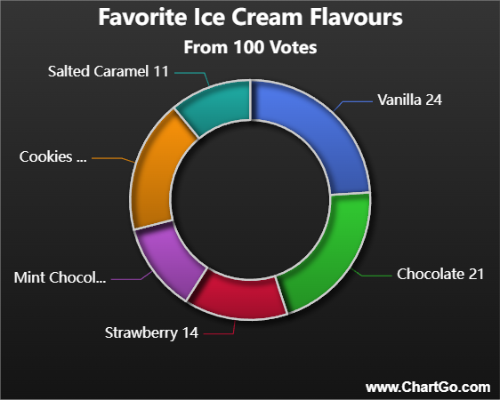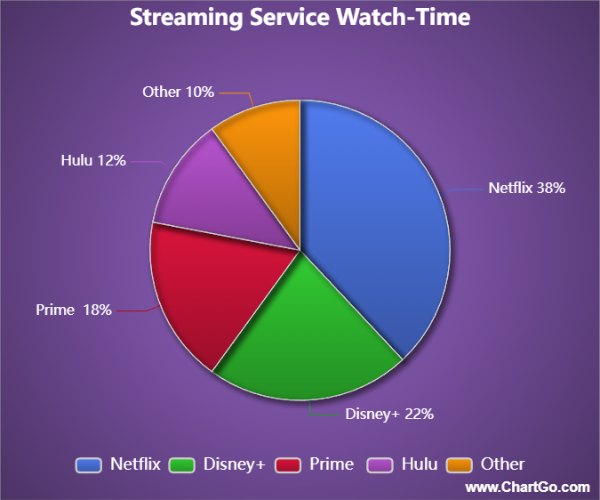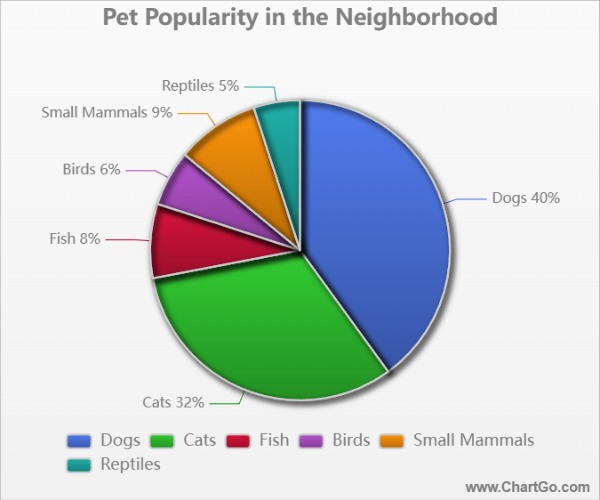
How to Create and Use Pie Charts with Examples
In this guide, we’ll explain what a pie chart is and when it makes sense to use one. We’ll also help you create your own pie chart instantly with ChartGo so you can visualize how each category contributes to the whole. Pie charts are ideal for showing proportions, percentages, and simple comparisons across categories. What does your data look like when each slice reveals its share of the whole?

What is a Pie Chart?
A pie chart is a circular chart divided into slices, where each slice represents a category’s share of the total. It’s a simple and effective way to show proportions, percentages, and how different parts contribute to a whole.
In simple terms, a pie chart answers one question: “Who gets which slice of the pie?” Whether you’re showing market share, budget distribution, or survey breakdowns, pie charts make it easy to compare categories at a glance.

Try This Pie Chart Example in ChartGo
Create a New Pie Chart
This pie chart illustrates the market share distribution across ten different product lines within a consumer goods company. Each slice represents the percentage of total revenue generated by that category. As the chart shows, Product A, Product C, and Product F drive the majority of the company’s revenue, while smaller product lines contribute modest but steady shares. Pie charts are ideal for quickly revealing dominant categories and identifying areas where growth opportunities may exist.
When to Use a Pie Chart
Pie charts are best when you want to show how each category contributes to the total. They make it easy to compare proportions, percentages, and relative sizes at a glance.
For example, if you’re visualizing market share, budget allocation, or survey responses, a pie chart highlights which segments dominate, which are smaller, and how everything fits together. It’s perfect for simple comparisons that emphasize parts of a whole.
Use a pie chart when you want to answer questions like:
- What percentage does each category represent?
- Which segment is the largest or smallest?
- How do two or more slices compare in size?
- What does the overall distribution look like?
If your goal is to highlight proportions or composition, a pie chart is the best choice. But if you need to compare values precisely or show many categories, a bar chart may communicate the information more effectively.
Create and Customize Your Own Pie Chart
Instead of just reading about pie charts, ChartGo lets you interact with one directly. Enter your categories, update the values, and see the slices resize instantly. It’s the fastest way to understand how proportions shift when your data changes.
You can also customize the visual style: turn your pie into a donut chart, display percentages, or enable smooth corners and thick borders for a clean, modern look. Whether you want a classic pie or a stylized presentation graphic, ChartGo gives you full control with just a few clicks.

Customize Pie Chart Example
Create a Pie Chart
So don’t just read about pie charts, build and modify them. You’ll quickly see how every small change helps tell a clearer data story.
Examples of Pie Charts in Action
Pie charts are perfect for showing how each category contributes to a whole. They’re ideal when you want to compare proportions, highlight dominant segments, or tell a simple story about distribution at a glance. Here are three fun examples that demonstrate how pie charts bring everyday data to life.
1. Favorite Ice Cream Flavors
See which flavors are most popular in a small survey.
A pie chart makes it easy to spot which flavors dominate and which are niche favourites.
2. Streaming Service Watch-Time Share
Compare how much time people spend watching different streaming platforms in a typical month.
The slices reveal which services truly capture viewer attention.
3. Pet Popularity in the Neighborhood
Visualize which pets households own most often.
This example shows how a pie chart can turn simple survey counts into a clear, memorable picture.
Favourite Ice Cream Flavors - Pie Chart
By Josie

This pie chart shows which ice cream flavors are most popular in a small group survey.
A few classic flavors dominate the chart, while others account for smaller but loyal preferences.
It’s a simple, fun example of how pie charts reveal dominant categories in a single glance.
Streaming Service Watch-Time - Pie Chart
By Alana

This pie chart compares monthly watch-time across different streaming services.
One platform clearly leads, while others share smaller but still significant portions of viewing time.
It’s a great example of how pie charts can quickly communicate where attention is really going.
Pet Popularity in the Neighborhood - Pie Chart
By Josie

This pie chart shows how common different types of pets are in a neighborhood survey.
Dogs and cats take up most of the chart, while smaller slices represent fish, birds,
small mammals, and reptiles. It’s a friendly, relatable way to show how interests are shared.
Expert Tips from the ChartGo Team
After years of watching users build pie charts, we’ve learned what makes a pie chart clear, impactful, and easy to read. Here are our best tips for creating great pie visuals:
- Use a limited number of slices: Pie charts work best with 4–6 categories. Too many slices makes the chart cluttered and reduces readability.
- Highlight key slices: Use colour contrast or the “percentage” feature to emphasize the categories that matter most. Your message becomes easier to understand at a glance.
- Consider a donut style: Donut charts often improve readability by placing focus on the ring, not the center. They also give space for labels or icons if needed.
- Order slices logically: Arrange slices by value, largest to smallest, or group similar categories together. This helps users interpret the chart faster.
- Use smooth corners and thick borders intentionally: These design options give a modern look but should be used sparingly if clarity is your top priority.
Remember: A pie chart is about parts of a whole. When designed well, it instantly reveals which segments matter and how they relate. ChartGo makes it easy to fine-tune colours, styles, and labels so your pie chart communicates clearly and beautifully.